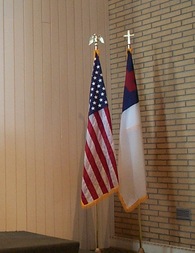
With all the recent battles over the issue of homosexual marriage, I thought that it would be good to share a presentation that I made a few years back entitled "What the Bible Really Says about Homosexuality." In this 45 minute lesson, I examine the biblical teaching regarding homosexuality in light of fifteen different verses which specifically address this topic. From those fifteen verses, I conclude that the Bible warns all governments that they have a responsibility to criminalize homosexual activity.
4 Comments
 In addition to the claim that the creation account in Genesis is poetic, there are also two additional arguments that are presented against the young earth interpretation. The first is an appeal to authority, and the second involves a dispute over the meaning of the word “day” in the creation account. I will deal with the first half of the first claim in this article, and address the others in subsequent posts.  In the previous article, I explained why I view the first two chapters of Genesis to be of the same genre as the rest of the book. There are, of course, several arguments which are brought against this view, and I’d like to briefly address a few of them before moving on. The first objection to my view is the claim that the order of the creation days reveals parallelism which is a feature of Hebrew poetry. This parallelism is supposedly seen in the fact that the days of creation are divided into two sets of three days and that the events of those two sets parallel each other as seen in the following table.  This is the first in a series of posts that may eventually turn into a book. I’ve been studying and debating the age of the earth for about fifteen years. I began in 1999 as a freshman in Bible college debating professors from UNC Charlotte in an internet discussion board. If you’ve read my book on the founding fathers, you know that I always prefer to read not just the original source but also the earliest printing of that source available, and I applied that same approach to the question of the age of the earth. Consequently, I’ve read things like Newton’s Principia Mathematica, Copernicus’ On The Revolutions of the Celestial Spheres, Einstein’s Relativity, “The Great Expansion” by Gamow, “The Inflationary Universe” by Guth and Steinhardt, A Brief History of Time by Stephen Hawking and many, many more. I am not a trained scientist in the sense of having received a science degree from a university, but I have hunted down the original source of every argument that I’ve met with in regards to the old age of the universe, and I’ve found them all to be severely flawed. Now, I’d like to share a little bit of what I have learned in the process, and I hope that you will add your comments to the discussion as well.  In my previous Bible Contradiction article, I explained the difference the hour of day at which John says that Jesus’ trial before Pilate ended and the hour at which Mark says that He was crucified, but there is another aspect of the timing of the crucifixion which is often claimed to be contradictory. According to several atheist websites including the Skeptics Annotated Bible, John’s account says that Jesus died before the Passover meal while Mark’s account places Jesus’ death after the Passover meal. It is claimed by these sites that these two accounts do not agree and must therefore be false. However, this apparent disagreement disappears once we understand what actually takes place during the Passover.  The crucifixion of Christ is the pivotal event of Scripture, but it is recounted to us from four different perspectives. This occasionally gives rise to statements which seem to be contradictory. When we come across these statements, it is important to consider the varying perspectives of the authors before jumping to the conclusion that there is a contradiction. Most of these differences of perspective are included in the Skeptics Annotated Bible list of contradictions, and today, I would like to use one of the most difficult of those supposed contradictions to demonstrate how easily they can be resolved if we view the gospels as four eyewitness accounts each given from a different point of view.  At the end of last month, I wrote a two-part article correcting Richard Carrier's view of American history. In a response to the second of those articles, reader edwardtbabinski presented a small barrage of challenges to the idea that America was founded as a Christian nation. Now, another of our readers, W. R. Miller, has written a point-by-point response to Edward's challenges and posted it on the Tekton Ticker blog. Mr. Miller does an excellent job of supporting each of his statements with quotes from original source material, but the thing that I like the most about his article is that each of those quotes is accompanied by a link to the source itself so that we can read the entire statement in context. I would like to encourage all my readers to follow this link to Mr. Miller's article and see for yourselves how strong the case is for the Christian heritage of our nation.  There has been much in the news lately about some new archaeological research that disagrees with the Bible. According to an article on the National Geographic website: Newly published research by two archaeologists at Tel Aviv University in Israel shows that camels weren't domesticated in the eastern Mediterranean until the 10th century B.C.—several centuries after the time they appear in the Bible.  In the book The Faiths of the Founding Fathers, Christian historian David Holmes made the following statement about John Adams: Like many of his contemporaries, he brought the religion in which he was raised into the court of his reason and common sense and judged it by what he found ... "Let the human mind loose," Adams once wrote in an outburst of Enlightenment passion. "It must be loosed; it will be loose. Superstition and despotism cannot confine it." He followed these words with the assertion that Christianity would surely triumph if the human mind were loosed. This statement indicates that Adams belongs somewhere in the category of Unitarian Christian or Christian Deist.  The subtitle to Sam Harris’ book The Moral Landscape is: “How Science Can Determine Human Values.” In the introduction to the book, Harris presented two opposing viewpoints on the origin of human morality. The first claims that morality is woven into reality by God while the second views morality as the product “of evolutionary pressure and cultural invention.” In regards to these two views, Harris says: |
Bill Fortenberry is a Christian philosopher and historian in Birmingham, AL. Bill's work has been cited in several legal journals, and he has appeared as a guest on shows including The Dr. Gina Show, The Michael Hart Show, and Real Science Radio.
Contact Us if you would like to schedule Bill to speak to your church, group, or club. "Give instruction to a wise man, and he will be yet wiser: teach a just man, and he will increase in learning." (Proverbs 9:9)
Search
Topics
All
Archives
June 2024
|


 RSS Feed
RSS Feed